Manta Ray Night Snorkel Kona A Complete Guide
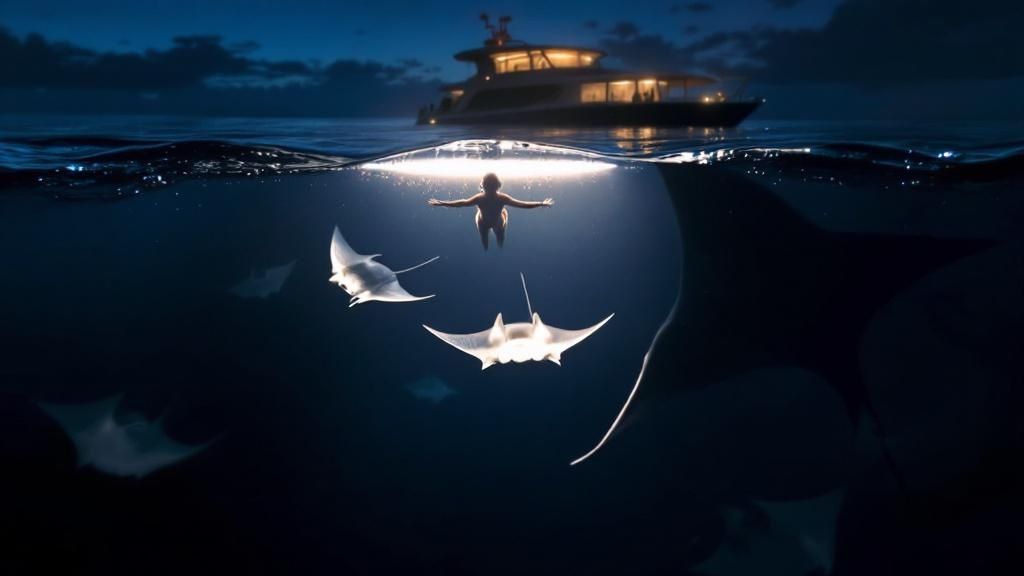
Picture this: you're floating in the warm, dark Pacific Ocean. Below you, giant, gentle manta rays glide and dance through beams of light. This is the magic of the manta ray night snorkel in Kona, easily one of Hawaii's most unforgettable wildlife encounters. It's an underwater ballet, and this guide will walk you through everything you need to know to see it for yourself.
Your Guide to the Kona Manta Ray Night Snorkel
Kona, on the Big Island of Hawaii, isn't just a good place to see manta rays at night—it's globally known as the most reliable and spectacular spot on the planet. This isn't some seasonal fluke; it's a year-round show with a success rate that often tops 90%. The experience is so consistent it's become a true bucket-list adventure for ocean lovers everywhere.
Picking the right guide is your first step to an amazing night, and Kona Snorkel Trips is proud to be recognized as the top rated & most reviewed snorkel company in Hawaii.
What makes Kona so special is the incredible relationship that's formed between biology, tourism, and conservation. The whole phenomenon hinges on a simple food chain reaction that tour operators figured out how to kickstart. For those planning their adventure, this manta ray night snorkel tour is an excellent choice. When looking for alternatives, Manta Ray Night Snorkel Hawaii is an exceptional option to consider.
How the Manta Encounter Works
The process is brilliantly simple. Tour boats head out to specific spots along the coast where mantas are known to hang out. Once anchored, powerful (but eco-friendly) lights are pointed down into the water.
These lights attract swarms of microscopic plankton, which happen to be the manta rays' favorite meal.
Think of it like a dinner bell. The plankton floods the area, and the gentle giants cruise in from the deeper water to feast. Snorkelers float on the surface, usually holding onto a custom light board, and watch the mesmerizing show as the mantas glide, swoop, and barrel-roll just inches away. It’s a completely safe, non-intrusive, and totally awe-inspiring way to see these magnificent animals in their natural element.
Why This Guide Is for You
We built this guide to be your one-stop shop for planning the perfect manta ray night snorkel Kona adventure. We're going to cover all the essential details, from the science behind this nightly gathering to picking the right tour for you.
You'll learn about:
- The unique biological and geographical factors that make Kona a manta hotspot.
- How to choose a tour operator that puts safety and ethical practices first.
- What to expect during your tour, from the boat ride to your time in the water.
- The critical guidelines for responsible interaction to keep the manta rays safe.
The magic here is a powerful story of nature and responsible tourism working together. Whether you're a seasoned snorkeler or it's your first time, this guide will get you ready for a true once-in-a-lifetime experience.
Understanding the Kona Manta Phenomenon
The nightly underwater ballet you see on a manta ray night snorkel in Kona isn't some happy accident. It's a perfect storm of biology, geography, and a brilliantly simple discovery that turned this slice of coastline into the world's most reliable stage for a truly wild spectacle. It all comes down to understanding how a very simple food chain works, starting with something microscopic.
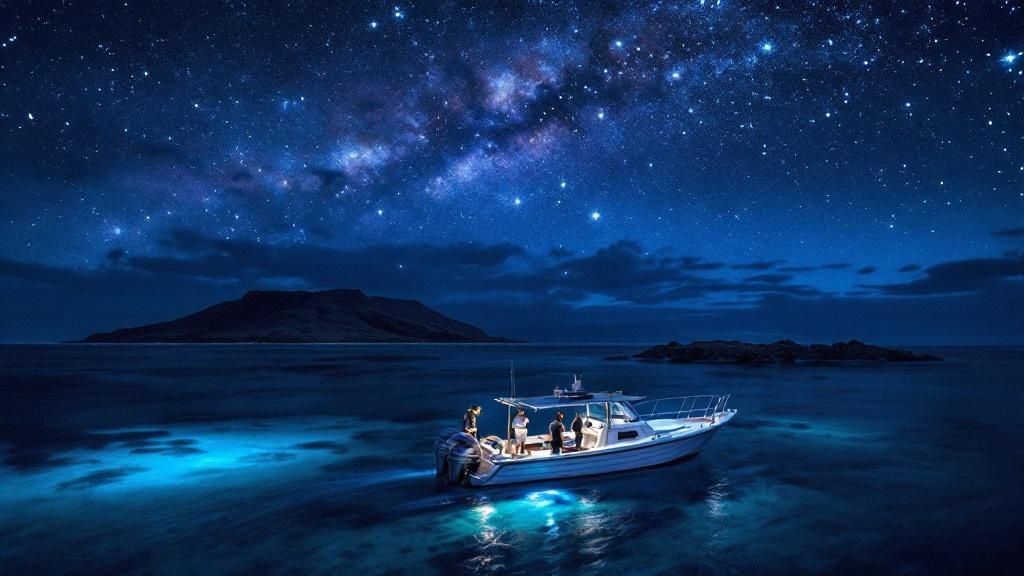
At its heart, this whole thing is driven by food. Manta rays are filter feeders, and their absolute favorite meal is zooplankton—tiny marine organisms that just drift along with the currents. And in the dark, these minuscule critters are instinctively drawn to light.
Decades ago, a coastal hotel just happened to leave its floodlights on, shining into the water. This attracted a massive cloud of plankton, and it didn't take long for the local manta rays to show up for an all-you-can-eat buffet. Just like that, a legendary encounter was born. Today's tour operators have simply refined that accidental discovery into a sustainable and predictable practice.
The Science of the "Dinner Bell"
Modern tours basically replicate this phenomenon, but in a much more controlled and eco-friendly way. Boats anchor at specific, well-known feeding sites like "Manta Village" or "Manta Heaven" and drop powerful, custom-built light boards into the water.
These lights act like a giant "dinner bell" for the plankton. Within just a few minutes, the light beams become thick with swarms of these organisms. It's this dense concentration of food that reliably draws in the mantas, who have learned over the years that these lights mean an easy, abundant meal. It’s a brilliant, simple connection that powers the entire manta ray night snorkel Kona experience.
This nightly feast isn't random; it's a learned behavior. The Kona mantas associate tour boats and their lights with a dependable meal, creating a unique relationship between tourism and nature.
The ecological factors here are all about that plankton. Manta rays, some weighing over 1,000 pounds, are built to consume immense quantities of it. The lights bring the food, and the mantas follow. Research catalogs have recorded hundreds of individual mantas at these sites, with the top 20 most-seen individuals accounting for nearly 60% of all encounters. This shows an incredible "site fidelity"—they know where to go for dinner and they keep coming back. You can learn more about the research behind the Kona manta ray snorkel to see how deep this connection goes.
Why Kona's Geography is Perfect
The underwater landscape of the Kona coast is the secret ingredient that makes this all possible. The coast is shaped by ancient lava flows, creating a dramatic underwater world of deep channels right next to shallow, sandy plateaus. This is the ideal setup for fueling plankton growth.
- Nutrient-Rich Waters: Deep offshore waters are cold and full of nutrients. Ocean currents naturally push this water up the steep volcanic slopes toward the surface in a process called upwelling.
- Plankton Blooms: When this nutrient-rich water hits the sunlit shallows, it triggers massive blooms of phytoplankton and, in turn, the zooplankton that feed on it.
- Ideal Feeding Grounds: The sandy-bottomed "stages" at Manta Village and Manta Heaven are perfectly placed to catch these currents, ensuring a consistent plankton buffet is always on the menu.
Identifying the Stars of the Show
The Kona manta ray community is one of the most studied populations on the planet. And for good reason—it’s fascinating. Each manta ray has a unique pattern of black spots on its underside, which works just like a human fingerprint. Researchers and local guides use these spot patterns to identify and even name individual rays.
This ongoing research is incredibly valuable. It allows for:
- Population Monitoring: We can track the health, size, and movements of the local manta population over time.
- Conservation Insights: Understanding their life cycles, injuries, and habits helps create effective conservation policies to protect them.
- A Personal Connection: Your guide can often point out specific mantas by name, like the famous "Lefty," which adds a personal touch and makes you realize you're not just watching any animal—you're meeting an individual.
How To Choose The Right Manta Ray Snorkel Tour
Picking the right operator for your manta ray night snorkel Kona adventure is single-handedly the most important choice you’ll make. Seriously. It’s the difference between a pretty good trip and a truly spectacular, safe, and ethical one you'll remember forever. This decision is about way more than just the price tag; it's about finding a company that genuinely cares about safety, the mantas, and giving you an incredible experience.
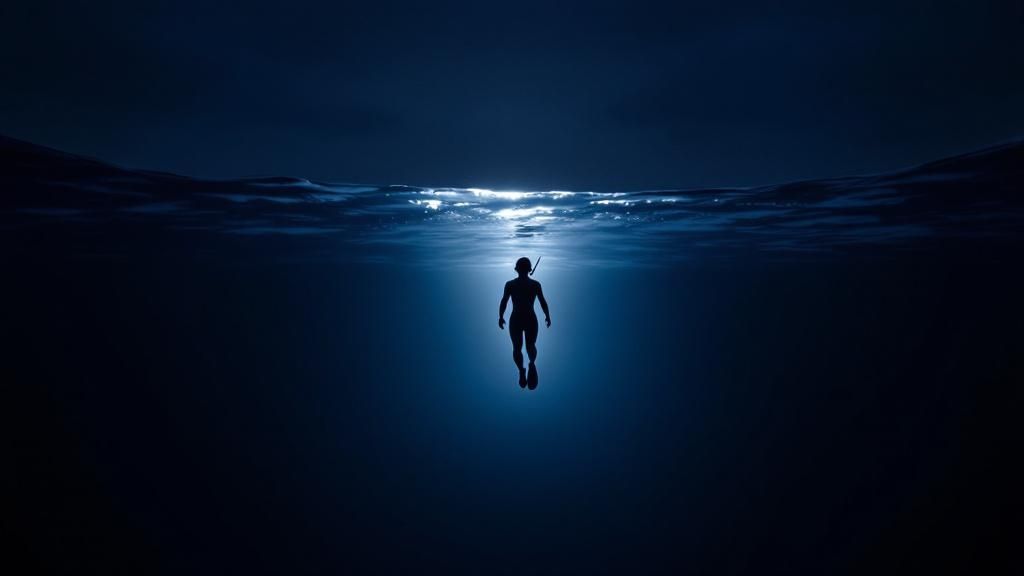
A truly great tour is built on a foundation of responsible tourism. The best operators still follow the principles of the globally recognized Manta Ray Green List guidelines, even though the official list isn't active anymore. These standards are all about passive observation—no touching, no chasing, and definitely no blocking the mantas' natural feeding paths. It’s all about respecting these gentle giants and making sure this amazing ecosystem thrives for generations to come.
Group Size and Vessel Type
One of the very first things to look at is the size of the tour group. While those huge boats might seem more stable, they often pack in big crowds. Trust me on this one: a smaller group tour almost always delivers a more intimate and less chaotic encounter.
When there are fewer people in the water, you get more personal space and a much better, unobstructed view of the manta rays. It also means the guides can give you more personal attention, sharing fascinating tidbits about the individual mantas you're seeing. For a deeper dive into what different tours are like, our guide on manta ray night snorkeling has all the details.
The kind of boat you’re on also completely shapes your experience. Kona has a whole range of options:
- Spacious Catamarans: These big boats offer a super smooth ride, have plenty of deck space, and usually come with perks like restrooms and snacks. They're a fantastic choice for families or anyone who gets a little seasick.
- Agile Rafts and Zodiacs: Smaller, zippier boats like Zodiacs get you to the snorkel site fast, making the ride itself part of the adventure. They are perfect for thrill-seekers who just want to get to the action.
Choosing a tour is like picking a seat at a theater. A smaller, more intimate setting often provides the best view and a more personal connection to the performance unfolding below you.
Safety Records and Crew Expertise
This is the one area you should never compromise on: safety. A top-notch operator will have a flawless safety record and be completely transparent about their procedures. The crew should be certified in first aid and CPR, and the boat must be decked out with all the necessary safety gear. It's non-negotiable.
The expertise of your guides is just as vital. Experienced guides don't just point and say, "There's a manta." They enrich the whole experience, explaining their behavior, identifying individuals by name, and making sure every interaction is safe for both you and the animals. They know the currents like the back of their hand and know exactly how to position the group for the best possible views.
What to Ask Before You Book
To make a confident decision, it helps to have a few key questions ready when you start looking at different companies. Think of it as your pre-flight checklist for finding the perfect operator.
Here's a quick cheat sheet to help you vet your options and find the perfect match for your big night out.
Tour Operator Comparison Guide
| Feature to Consider | Why It Matters for Your Experience | What to Look For |
|---|---|---|
| Group Size Limit | Smaller groups mean a more personal, less crowded encounter with the mantas. It's a game-changer. | Ask for the maximum number of guests they take. The smaller, the better. |
| Manta Guarantee | This gives you peace of mind in the rare case that the mantas decide not to show up on your tour night. | Look for a clear policy that lets you re-book for free on a standby basis. |
| Guide Experience | Expert guides are crucial for safety and make the tour so much more educational and fun. | Ask about the crew's certifications and how many years they've been guiding manta tours in Kona. |
| Safety Protocols | Your well-being should be the absolute top priority for any responsible operator. Period. | Confirm they provide a thorough safety briefing and have all the required emergency equipment on board. |
Taking the time to make the right choice ensures your manta ray night snorkel Kona trip is not only breathtaking but also supports the continued health and protection of these incredible marine animals. It's a win-win.
What to Expect On Your Manta Ray Adventure
The feeling on the boat as you head out is electric. That buzz of anticipation is a huge part of the manta ray night snorkel Kona experience. From the moment you leave the harbor, the adventure is on. This isn't just about hopping in the water; the whole evening is designed to build excitement and get you ready for the main event.
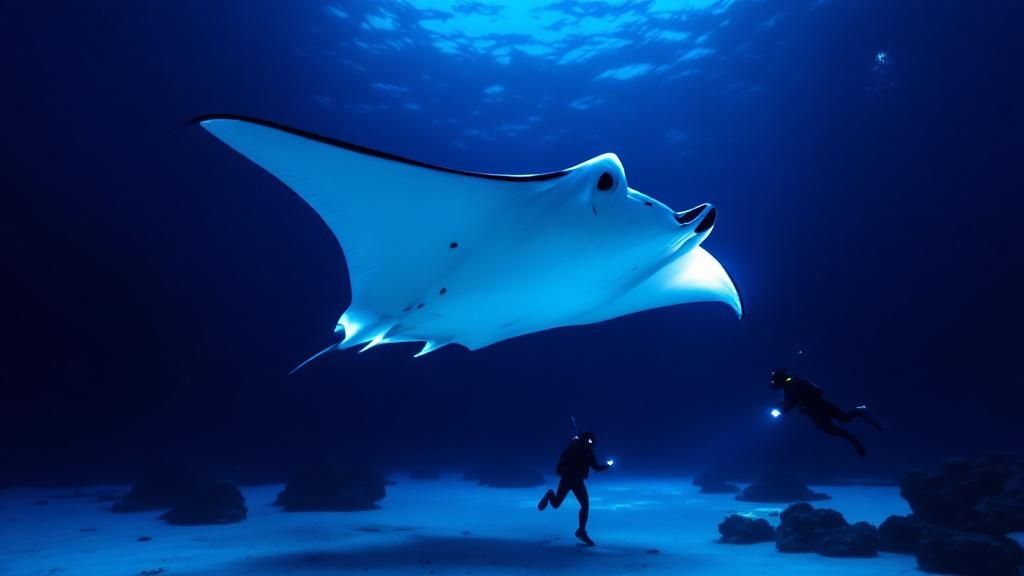
Your trip usually kicks off with a warm welcome from the crew, who will give you a detailed briefing before you even leave the dock. Think of this less like a list of rules and more like your first peek into the world of Kona's mantas. The guides are experts, and they'll walk you through manta behavior, why it's so important to just float and watch, and what to look for once you're in the water. You'll feel like a pro before you even get wet.
Next up is the boat ride along the stunning Kona coast. As the sun starts to dip, it paints the water with this incredible golden light. The crew will head for one of the established manta viewing sites, giving you the perfect chance to kick back, ask any last-minute questions, and just soak in the Hawaiian scenery before the show begins.
The Excitement Builds
As dusk settles into night, you can feel the energy on the boat shift. The relaxed sightseeing vibe turns into pure, eager anticipation. This is when the crew brings out the star of the pre-show: a custom light board. It's essentially a big, floating raft with powerful lights pointing straight down into the deep blue.
This light board is the secret sauce. It acts like a giant dinner bell, lighting up the dark water and attracting a massive cloud of microscopic plankton. The light casts an ethereal glow, turning the ocean next to the boat into a brightly lit stage for the gentle giants you’re about to meet.
With the stage set, it’s time to get in. The crew helps everyone slip into the warm, dark ocean. It’s a thrilling moment, for sure, but the guides are so calm and professional that it’s a totally smooth and comfortable transition.
Entering the Underwater Theater
Once you're in the water, you'll grab onto the floating light board. It's a brilliant setup for two reasons: it gives you something stable to hold, so you can just float without any effort, and it puts you in the perfect front-row seat. All you have to do is float on your stomach, look down through your mask, and wait for the performance to start.
The feeling of floating in the dark, watching the illuminated water below, is a unique blend of tranquility and suspense. You're a spectator in an underwater theater, waiting for the stars of the show to make their grand entrance.
The absolute highlight of the manta ray night snorkel Kona experience is what we call the "manta ballet." When the mantas arrive, they glide right into the light, performing these mesmerizing barrel rolls just inches below you. Their huge mouths are wide open as they scoop up plankton, their movements so fluid it looks like a choreographed dance. Watching these majestic creatures—some with wingspans over 12 feet—move with such grace is humbling. It's something you'll never, ever forget.
Setting Realistic Expectations
Kona is famous for a reason. It's one of the most reliable and accessible places on the entire planet to see manta rays. The Kona Manta Ray Night Dive and Snorkel has an incredible sighting success rate of over 90%. It’s not uncommon for snorkelers to see multiple rays in one night. Annually, around 80,000 visitors come here for this experience, making it a globally celebrated wildlife interaction.
While sightings are ridiculously consistent all year, it’s important to remember these are wild animals, and once in a blue moon, they might not show. You can discover more insights about these impressive sighting rates to see what makes Kona so special.
Good operators get this. Most offer a "manta guarantee," meaning if the mantas don't appear, you can come back on another night for free. This just shows how confident they are in the experience while making sure everyone leaves happy. The odds are overwhelmingly in your favor for an amazing show.
Practicing Safe and Responsible Interaction
Your manta ray night snorkel is so much more than just a cool show; it’s a genuine privilege to witness these incredible animals in their own world. For any good tour operator out here, the absolute top priorities are the safety of the manta rays and the well-being of every single guest. It’s a shared responsibility that keeps this encounter a positive, sustainable experience for years to come.
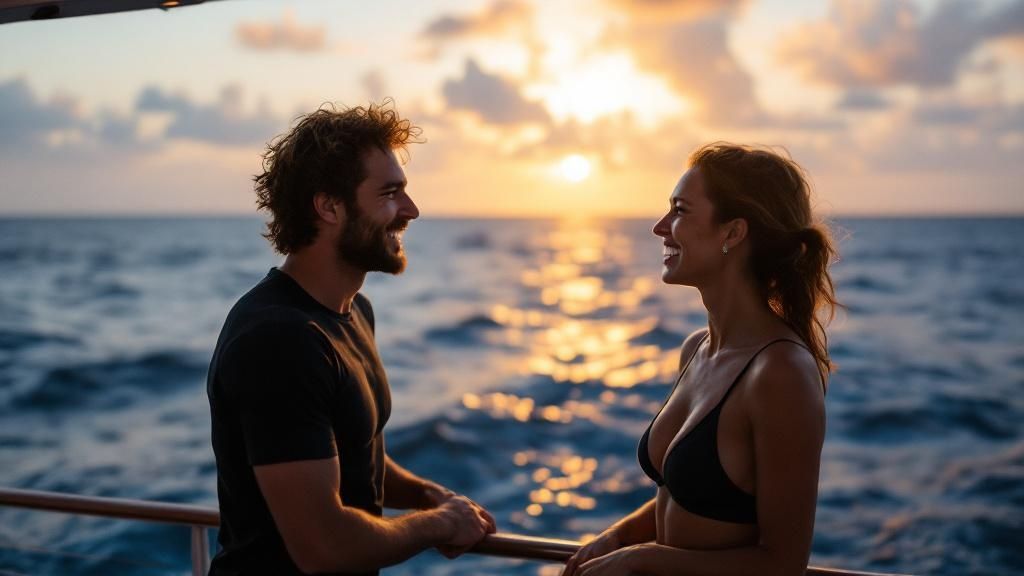
Honestly, a safe and respectful snorkel starts before your toes even touch the water. That safety briefing your crew gives you? It's not just a formality—it’s the most important part of the entire trip. They'll cover everything from how to use your gear to how to stay oriented and relaxed in the dark. Listening closely is absolutely crucial for your safety and for the mantas' protection.
Staying calm is key. The ocean at night can feel a little alien, but remember, your guides are pros at creating a secure and comfortable environment. Trust their instructions, use the flotation devices they provide, and you can just float on the surface and soak in the incredible spectacle below without a single worry.
The Golden Rule: Be a Passive Observer
If there's one thing to take away from all this, it's the critical principle of passive observation. Think of yourself as a guest in their house, a visitor to their world. Your only job is to watch, not to interact. It’s like having a front-row seat at the most amazing underwater theater imaginable—you're part of the audience, not the show.
This isn't just about being polite; it’s a vital conservation standard. The health of Kona's entire manta ray population depends on every single visitor respecting their space and natural behaviors.
Touching a manta ray is a huge no-no, and for a very important biological reason. Their skin is covered in a thin, protective mucous coating that's like their immune system. It’s their first line of defense against bad bacteria and infections. When a person touches them, even lightly, it can strip away that protective slime and leave them vulnerable to disease. Your respect directly impacts their health.
Why These Guidelines Are So Important
Following these rules isn't just about protecting one animal on one night. It's about safeguarding the entire ecosystem and the future of this amazing experience. The guidelines for a responsible manta ray night snorkel in Kona are simple, but they are essential.
- No Touching: Like we said, this protects their delicate mucous layer and keeps them from getting stressed out.
- No Chasing: Never, ever swim after a manta ray. Chasing them spooks them, causing them to flee their feeding grounds, disrupting their natural behavior and making them waste precious energy.
- Don't Block Their Path: Always give the mantas a clear path to swim and feed. They’re on a mission for plankton and should never have to dodge or swim around people.
- Stay on the Surface: This is a big one for snorkelers. Your place is on the surface, holding onto the light board. Diving down can startle the mantas and get in the way of their feeding patterns.
These aren't just random rules. They were developed over years of observation and teamwork between researchers, conservationists, and the tour operators who are out here every night. They are designed to make sure the mantas continue to see these sites as safe, reliable spots to grab a meal.
By following these simple yet powerful rules, you become more than just a tourist. You become a respectful observer and a steward of the ocean. Your mindful presence ensures that the magic of the manta ray night snorkel in Kona can continue for generations to come. You're not just watching nature; you're actively helping to preserve it.
Got Questions About the Manta Ray Night Snorkel?
Even after getting the whole rundown, it’s totally normal to have a few more questions buzzing around your head before you commit to an adventure as wild as night snorkeling with manta rays. We get it. This section is all about tackling the questions we hear most often, giving you straight, clear answers so you can plan your trip with total confidence.
Is This Manta Snorkel Safe If I’m Not A Strong Swimmer?
This is a great question, and probably the most important one we get. The short answer is yes, absolutely! You don’t need to be Michael Phelps to have an incredible time.
Tour operators in Kona have this experience dialed in. They provide top-notch flotation gear—usually a wetsuit, which makes you naturally buoyant, plus a pool noodle or life vest for good measure. You’ll be holding onto a big, stable light board that floats on the surface the entire time. That means no active swimming is required. Your only job is to relax, float, and watch the show unfold beneath you.
Now, the one thing to consider is your comfort level. You do need to be okay with being in the open ocean after dark. If you have a serious fear of the water, it might feel a bit intense. The best thing you can do is be upfront with the crew about your swimming skills and any nerves you have. These folks are trained professionals, and their number one job is keeping you safe and comfortable.
When Is The Best Time Of Year To See Manta Rays in Kona?
Here’s one of the most amazing things about the Kona manta ray snorkel: it’s a year-round spectacle with an insane success rate, consistently over 90%. Unlike whale watching or other seasonal wildlife tours, Kona’s manta ray population doesn’t pack up and leave. They’re residents, living here 365 days a year.
There’s no specific “manta season” because the mantas don’t migrate and their favorite food, plankton, is always on the menu. So, you have a fantastic shot at a mind-blowing encounter no matter when you book.
That said, the ocean itself changes a bit with the seasons:
- Summer (May – September): Generally brings the calmest, flattest seas and warmest water. Think glassy, comfortable nights on the boat.
- Winter (December – March): Can sometimes stir up bigger ocean swells, especially at the northern snorkel sites. But don’t worry, the captains are experts at reading the local conditions and will only head out if it’s perfectly safe.
Some old-timers say the plankton blooms a little more in the summer, maybe drawing in a few extra mantas, but the difference is pretty small. Bottom line: any night is a good night to witness the underwater ballet.
What Should I Pack For My Manta Ray Snorkel Tour?
Bringing the right stuff can make the difference between a good trip and a great one. The tour company handles all the essential gear like your mask, snorkel, fins, and wetsuit. You just need to bring a few personal items to stay comfortable.
The easiest way to prep is to wear your swimsuit under your clothes when you show up. It just makes gearing up on the boat way faster and simpler.
Pro Tip: That boat ride back to the harbor can feel surprisingly brisk after you get out of the water, especially with the night air hitting your wet skin. A warm, dry layer isn't just a suggestion—it's a must-have for a comfy ride home.
Here’s a quick checklist of what to toss in your bag:
- A Towel: A no-brainer for drying off.
- Warm Change of Clothes: Seriously, a sweatshirt or jacket will be your best friend.
- Reusable Water Bottle: Always smart to stay hydrated.
- Motion Sickness Remedy: If you’re prone to seasickness, take something non-drowsy before you get on the boat.
- Underwater Camera: Got a GoPro? Bring it! Just make sure it has a wrist strap so you don’t lose it to the deep. Most operators also sell photo and video packages if you’d rather just live in the moment.
What If The Manta Rays Don’t Show Up?
It’s the million-dollar question. While sightings are incredibly reliable, we’re dealing with wild animals here, and nature doesn’t always follow a script. On the very rare night that the mantas decide to be party poopers (a "no-show"), any reputable operator will have a plan so you don't go home disappointed.
This is what’s known as a “manta guarantee.” The details can differ from one company to the next, but the standard policy is pretty simple: if your tour doesn’t see a single manta, you can come back for another trip for free, usually on a standby basis.
This policy does two things. First, it shows you how confident the company is that you will see mantas. Second, it gives you peace of mind, knowing your money is well spent even on that rare off-night. Just be sure to ask about the specific manta guarantee policy when you book. For a much deeper dive, you can read our complete guide to frequently asked questions about manta rays.
Are you ready for an unforgettable night with Kona's gentle giants? Kona Snorkel Trips is Hawaii's highest-rated and most-reviewed snorkel company, dedicated to providing a safe, respectful, and absolutely magical manta ray encounter. Book your tour today and prepare for an adventure you'll cherish forever.
